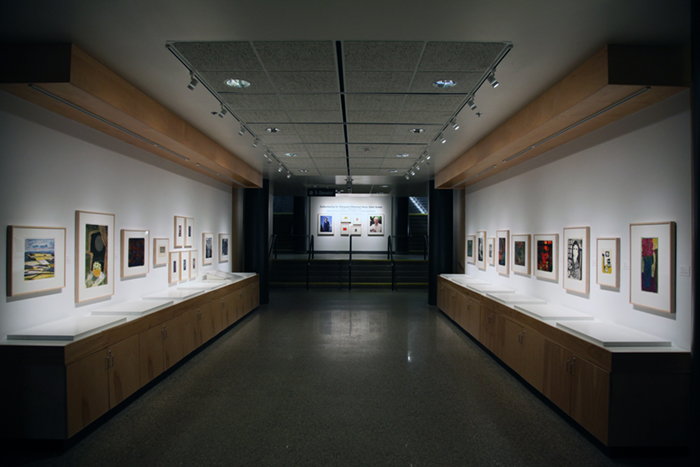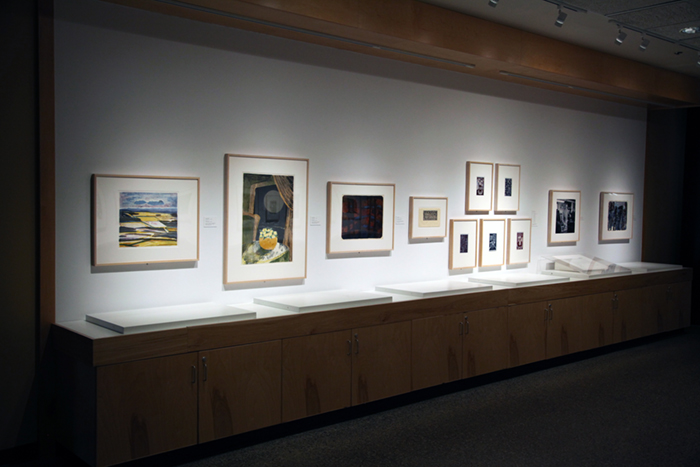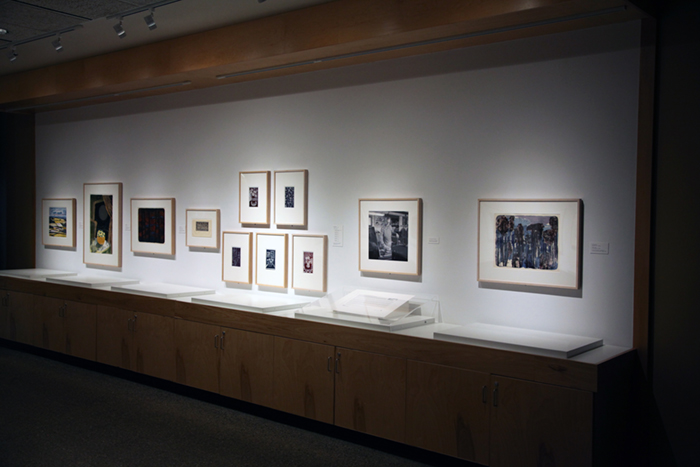Helen Christou Gallery
Collected by Dr. Margaret (Marmie) Hess: John Snow
June 13 – September 6, 2019
Works from the uLethbridge Art Collection
Curated by David Smith
As a longtime friend of the Snow family and an active participant in the art scene in Calgary for many decades, the late Dr. Margaret (Marmie) Hess collected works by John Snow. This exhibition focuses on the lithograph and lino-cut prints created by Snow.
Curatorial Statement:
John Snow was a Canadian artist active in Calgary during the second half of the twentieth century and was known as a pioneer of lithographic printmaking in western Canada. In 1946, Snow took a life drawing class at the Provincial Institute of Technology and Arts (now SAIT and Alberta University of the Arts) from Maxwell Bates, an artist who he would go on to collaborate with many times over the following decades. Snow got into printmaking when advances in photographic reproduction contributed to commercial lithography becoming obsolete in the 1950s. At that time, Calgary’s Western Printing and Lithography Company upgraded their technology and got rid of their presses and stones which Snow rescued from the alley behind the business in March of 1953. Subsequently, he got a book from the library that taught him how to set up the presses in his basement and how the lithographic process worked. Snow produced over 400 print editions during his career and assisted other artists like Maxwell Bates and Illingworth Kerr with printmaking as well.
Among Snow’s most popular work are his still life prints which often use bright bold colour. These images were some of his most commercially successful and ultimately found the largest audience. The still life works explore a modernist interest in experimenting with abstraction using colour, shape and line to flatten the picture plane. In works like Red Still Life, (1966) the fruit bowl both sits on top of the table and hovers in front of it. In Clopton, (1972) Snow has utilized dramatic foreshortening of the table top and flattens the surfaces through applying texture and creating a challenging relationship between the size of the coffee pot and coffee mug. Snow’s interior still life scenes also explore, in more complex ways, notions of emotional, physical and psychological absence.[1] This can be seen in his inclusion of unoccupied chairs, and suggestion of people outside of the image.
In 1954 Snow’s first wife Bula Mae passed away after five years of marriage leaving him with his two year old son John Vance. Many of his prints from the late 50s and 60s are dark and moody and reflect emotional distress. In the following three years after Bula Mae’s death, art historian Elizabeth Herbert writes, “…several iconographical themes make their appearance. The image of the mother and child, the prominent empty chair facing the viewer, and looming, melancholic and largely female head and shoulder motifs become fixtures within his oeuvre.”[2] From as early as the Surrealist movement in the 1920s, artists had been interested in the writings of Sigmund Freud and Carl Jung which presented more complex ideas about the relationships between parents and their children. Snow’s uncanny images of mother figures indicate that he was aware of psychoanalytic theories and was working to subvert the conventional approach to the theme by presenting off-putting, menacing and unknowable feminine figures.[3]
Two thirds of the pieces included in this exhibition were collected by the late Dr. Margaret (Marmie) Perkins Hess and were gifted together with more than a thousand other artworks to the University of Lethbridge by her estate in 2017. Dr. Hess was an art historian and collector of Canadian and international art and knew the Snow family well. Archival documents at the University of Calgary Archives and Special Collections indicate that Dr. Hess was friendly with the whole Snow family and gifted them books, magazines and art objects over the years. In 1963, Snow married Kathleen (Kay) Allen. She was a teacher and librarian who shared a mutual interest in education and art history and who wrote a biography of Maxwell Bates in 1993. The small prints on the end wall are from greeting cards made by John Snow and sent by Kay Snow to Dr. Hess. The Snows were very active in the Calgary arts community and participated in activities at Coste House, an institution dedicated to the advancement of contemporary art, where Dr. Hess was an early supporter. Upon seeing an exhibition of work by Snow and Bates in 1957 at the New Design Gallery in Vancouver, Dr. Hess wrote to Snow with feedback and expressed interest in purchasing his work to which Snow replied “to be included in your Canadian Collection would be a real honour and be a highlight to a good year.”[4]
The provenance records accompanying the Hess collection indicate that Still Life 1956, Woman and Child (1957) and Table (1957), were all purchased in 1957. The records also indicate that Snow advised her on a number of her works purchased from Maxwell Bates. Snow exhibited annually at Dr. Hess’s commercial gallery, Calgary Galleries Ltd. in the 1970s and he sent her invitations to his exhibitions elsewhere as well. A lovely dedication is written on the title line of Untitled (Lady and Flowers), (1969) that reads, “Printed specially for Marmie Hess”. Dr. Hess kept her Snow prints for nearly six decades and had them in her possession until her passing in September of 2016, four months after her 100th birthday.
David Smith
Assistant Curator / Preparator
[1] Herbert, Elizabeth. The Art of John Snow (Calgary, Alberta: University of Calgary Press, 2011), 117.
[2] Herbert, The Art of John Snow, 35.
[3] Herbert, The Art of John Snow, 84.
[4] Correspondence from John Snow to Dr. Margaret (Marmie) Hess, Undated, 2017.76, Box 2, Margaret P. Hess Fonds, University of Calgary Archives and Special Collections.






